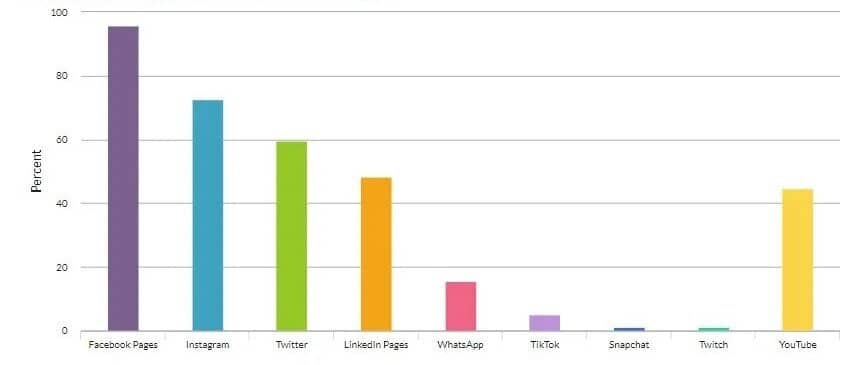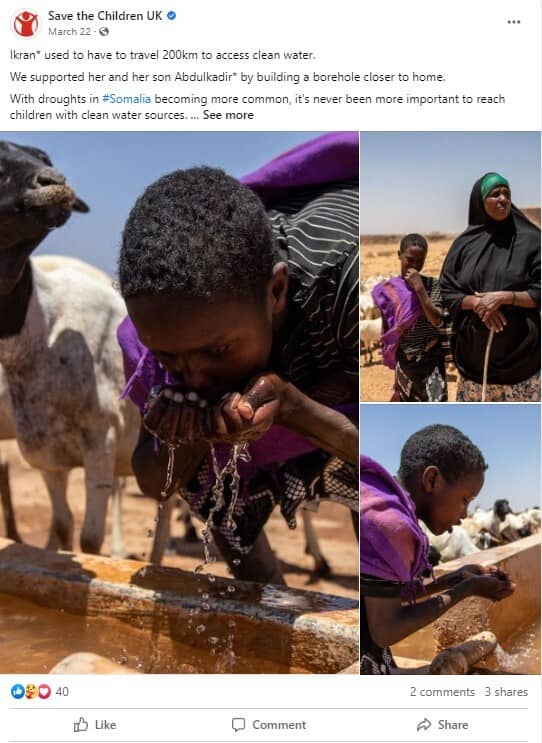Best Practices in Social Media Engagement for NGOs
Social media strategies for NGOs present three main functions: inform, socialize, and mobilize. Check out how you can increase engagement for your Nonprofit.

Do NGOs need to be present online? The answer is a resounding yes.
However, non-profit institutions should consider an active social media presence. Because outdated and non-interactive social media profiles will do more harm than good to develop your organization.
Fortunately, this article provides tips for promoting essential social media strategies for nonprofits.
Why is social media engagement important for nonprofits?
First this: Grow faster than ever before!
Seamlessly blend creativity and technology. See how you can start with AI Marketing and reach your goals faster than ever before. Check out the Tips, Strategies, AI Tools, Masterclass, Courses, and Community. Unleash the true potential of your brand with the help of AI.

Social media for NGOs have become a platform to contact their partners and donors.
This means that social media for nonprofits can become a perfect space for:
- informing about the activities
- increasing donation awareness
- conducting conversations with potential contributors
- sharing personal stories and success examples
- organizing a community
- presenting fundraising goals and collections
- reporting
- thanking and expressing gratitude
Still wondering how to make contributors feel part of your organization and stay with it for longer? Engaging with them on social media is a simple yet effective way to do that.
7 Best Practices in Social Media Engagement for NGOs

Develop communication with your followers and contributors using social media engagement practices. Let’s explore the most important tactics below.
1. Define social media strategy and audience
You don’t need to invent anything new to build a strong nonprofit brand. But you need to build a strategy to properly and consistently present the stories behind your organization, achievements, and more. Having a plan is how to remember your social networks.
A social media engagement strategy includes:
- objectives you pursue
- why did you appear on social networks
- audiences with whom you want to start conversations
- which platforms to choose, and the role of each of them
- what type of content you will publish and how often
- your virtual personality within social networks
- tone, style, and type of interactions to maintain
Not all groups of people related to your NGO are your potential audiences. Occasionally, you have connections with workers, volunteers, lifelong partners, and special suppliers. However, apart from this “heart group,” the other target audiences have different needs and interests.
We recommend you clearly define the groups you want to speak to and design a strategy for each. These may be:
- your current beneficiaries and their families
- entities in the field
- groups of people concerned with specific issues
- decision-makers and influencers
Having a well-structured and segmented social media strategy, you can engage with different groups better and provide them with the most relevant content consistently.
2. Choose social media platforms
The choice of which platform to use can make a significant difference. Each of them may give you access to certain features, depending on your goals and operation mode.

Most popular social media for NGOs. Source: Nonprofit Tech for Good
While new social media channels may grow in popularity, Facebook remains the dominant player. Its strengths include a vast potential audience and functional amenities. However, among its weaknesses are algorithms that limit reach, high content competition, and a preference for entertaining content.
YouTube is another platform with a vast potential audience. And people can find videos through Google. Its strength lies in the quality of its content, which though must be engaging and interesting to make a difference.
Twitter, as a social medium for nonprofits, offers direct access to politicians and journalists. Its strengths include many valuable discussions and high citations of the source. However, it requires knowledge of Twitter-specifics and constant activity on the site, as it’s easy to get lost in the crowd of other content.
Instagram is a platform known for reaching younger users. However, creating high-quality content can be challenging and requires skill and experience.
LinkedIn is often overlooked. But it offers many advantages due to its professional character and business specificity. It is a valuable tool for finding volunteers or reaching people responsible for company volunteering activities.
It’s also worth watching other platforms like Tumblr, WeChat, and numerous YouTube alternatives. It’s impossible to predict which platforms will become popular enough in the future, so it’s best to stay informed and open to new possibilities.
3. Use a social media posting plan
An important aspect of the effectiveness of social media strategy for NGOs is the shape and direction of the published content.
First of all, you must determine what your posting frequency will be. For example, you can publish one post daily on Facebook and three on Twitter. Then, define what types of content you will reveal and what objectives each one has.
Using social media management tools, you can streamline these processes, while social media analytics tools will help you in refining your plan with time.
Social media platforms can have different impacts on the users. In turn, it determines the types of digital posting strategies to prepare:
- Agitating is characteristic of mature organizations that want to mobilize society on their terms.
- The conversation strategy involves a two-way exchange of information between the organization and the followers.
- Finally, support and mediation stand behind the organization’s decision to transfer control of campaign goals and their implementation into the hands of supporters.
An excellent example of combining social media engagement in advocacy activities is the Fridays for Future movement initiated by Greta Thunberg. It uses peer-style dialog to agitate school children worldwide to undertake independent pro-climate initiatives in their own countries.
4. Emphasize visual content
Social media is one of the most effective ways to help people feel deeply identified with your cause. Share tips related to your work and say more about your organization’s mission.
Here is an example from the “Save the Children” account.

Source: Save the Children Facebook
As soon as we saw this post, we knew it was a great example to share. The image is emotional and captivating (perfect for Facebook).
The post personalizes the organization’s work, letting parents share their concerns about children’s problems in different places.
The following approaches can be used when preparing a social media engagement message:
- gain attention – use something that will attract the attention of users
- state personal references – allow the audience to identify with the case
- post something unexpected – people’s curiosity should be stimulated
- a good photo or video is worth more than a page of text and has a better chance of reaching the recipient
- affect the senses – if possible, try to engage other senses besides sight, i.e., hearing.
5. Communicate with your audience
When running a social media account, it is worth diversifying communication. Posting for the sake of the post itself is not yielding results.
The goal is to grab your audience’s attention and motivate them to listen, understand, and respond further. To achieve this, diversify forms and publish photos from actions, preparations for them, behind-the-scenes of NGOs work, or educational graphics. Create a unique atmosphere so that subscribers willingly look at the profile in search of interesting content.
By the way, test what resonates with the audience. Once you’ve engaged the community, discuss it with followers. Always be kind and thank them for positive comments or shares, and also for negative ones. React, explain, and translate as needed.
This will help increase discussions and positive mentions.
6. Use hashtags and profile descriptions
Another effective practice for NGOs to engage with their audience on social media is to use hashtags and profile descriptions.
NGOs should pay special attention and use AI tools like OpenAI and other ChatGPT alternatives for storytelling. It is nothing more than telling a story when considering the willingness to engage recipients in their activities.
Related: Best ChatGPT Alternatives.
Storytelling lets you present the organization: its mission, vision, idea, goals, and impacts. It defines your Reason To Believe, which is why people should believe in your organization and its activities. This is a very good way to attract attention to your project or the campaign you have in hand.
Be clear and truthful in your profile description. When it comes to people’s trust, it’s important to justify it fully. Feedback fields, legal information, and reporting increase people’s interaction.
Also, don’t forget to use the magic power of the hashtag. A well-sorted mention of an important event such as #InternationalEarthDay or #Children’sDay can dramatically increase your audience. Therefore, it’s high time to use them and show them to the world.
7. Analyze your activities
Now we hope you better understand your starting point. But your social media engagement journey is only to begin when you start reflecting on what you have achieved. You must measure the results of your activity. It is the only way to know if your plan of social media marketing for nonprofits is working or not.
Use Google Analytics, Facebook Insights, YouTube Analytics, or Twitter Analytics. Remember the KPIs that you established in the first phase when you carried out an audit of your website and your social networks. Otherwise, you will not get a plan but a wish letter.
To have a full view of your social media activities, you can build dashboards and reports, for instance, in Looker Studio. Implementing Looker Studio funnel visualization is a way to overview your performance and metrics for all the social media platforms you use.
Based on the analytics, implement improvements and adjustments. Once you have detected errors and found areas for improvement, set up actions that allow you to correct those errors and move forward in achieving your goals.
Conclusion
Social media strategies for NGOs present three main functions: inform, socialize, and mobilize.
Nonprofits use social media-specific content – from textual posts to BTS videos – to increase public awareness of their activities, build sustainable communities of supporters, and encourage them to take desired actions.
The ultimate goal is to guide a social media user through the life cycle of an NGO supporter, from an individual who is aware of the organization’s existence to an activist who is ready to take specific actions for the benefit of all humanity.
FAQ
What Are Social Media Engagement Best Practices for NGOs?
Best practices include regularly posting relevant and impactful content, actively engaging with followers through comments and messages, using storytelling to connect with audiences, and leveraging hashtags and trends for wider reach.
Why Is Social Media Engagement Important for NGOs?
Social media engagement is crucial for NGOs as it helps build community, increases awareness of their cause, drives donations and volunteerism, and enables direct communication with supporters and beneficiaries.
How Often Should NGOs Post on Social Media to Maximize Engagement?
NGOs should aim to post regularly, but the frequency can vary depending on the platform and audience. A consistent posting schedule helps maintain visibility and engagement with the audience.
What Types of Content Tend to Drive the Most Engagement for NGOs on Social Media?
Content that tends to drive engagement includes impactful stories, updates on projects and campaigns, behind-the-scenes glimpses, volunteer and beneficiary testimonials, and informative posts related to the NGO’s cause.
How Can NGOs Use Hashtags Effectively on Social Media?
NGOs can use relevant and trending hashtags to increase the visibility of their posts, participate in broader conversations, and reach audiences interested in specific topics or causes.
What Role Does Visual Content Play in Social Media Engagement for NGOs?
Visual content like photos, videos, and infographics plays a significant role in engagement, as it can convey messages powerfully, evoke emotions, and is more likely to be shared, increasing reach and impact.
How Important is Responding to Comments and Messages for NGOs on Social Media?
Responding to comments and messages is crucial for NGOs as it fosters a sense of community and shows that the organization values its supporters and is open to dialogue.
Can Live Streaming on Social Media be Effective for NGOs?
Live streaming can be highly effective for NGOs as it offers real-time interaction with followers, can be used for virtual events, Q&A sessions, and provides an immediate, authentic way to connect with the audience.
How Can NGOs Measure Social Media Engagement?
NGOs can measure social media engagement through metrics like likes, shares, comments, reach, impressions, and follower growth. Analyzing these metrics can provide insights into content performance and audience preferences.
What Are Some Common Mistakes NGOs Should Avoid on Social Media?
Common mistakes include posting too infrequently, being overly promotional, not engaging with the audience, neglecting the use of visuals, and failing to align social media strategy with overall organizational goals.
How Can NGOs Use Storytelling to Boost Social Media Engagement?
NGOs can use storytelling to share impactful stories of their work, beneficiaries, and volunteers, creating emotional connections with audiences and encouraging shares and interactions.
What Is the Significance of Social Media Analytics for NGOs?
Social media analytics help NGOs understand their audience, track the performance of their posts, and refine their strategies based on what content types and topics resonate most with their followers.
How Can NGOs Leverage User-Generated Content on Social Media?
NGOs can encourage supporters to share their own stories and experiences related to the cause. User-generated content can enhance authenticity and broaden the reach of the organization’s message.
What Strategies Can NGOs Use to Increase Followers on Social Media?
To increase followers, NGOs can engage in cross-promotion with similar organizations, participate in social media challenges, use relevant hashtags, and consistently post engaging and valuable content.
How Do NGOs Balance Fundraising Messages with Other Content on Social Media?
Balancing fundraising messages involves mixing these appeals with other types of content like educational posts, stories, and updates, ensuring that followers receive a varied and engaging experience.
What Role Do Influencers Play in NGO Social Media Strategy?
Influencers can play a significant role by amplifying the NGO’s message, reaching larger or new audiences, and lending credibility and visibility to the organization’s cause and campaigns.
How Can NGOs Ensure Their Social Media Content Aligns with Their Brand?
To ensure alignment with their brand, NGOs should maintain a consistent tone and style across posts, reflect their values and mission in their content, and use visuals that resonate with their brand identity.
What Are Effective Ways for NGOs to Use Social Media for Advocacy?
Effective ways include sharing compelling narratives and data, mobilizing supporters for online campaigns, engaging in relevant online conversations, and leveraging hashtags to join broader movements or causes.
Can Collaboration With Other Organizations Enhance Social Media Engagement for NGOs?
Collaboration with other organizations can enhance engagement by reaching wider audiences, sharing resources and content, and participating in joint campaigns or events.
How Important Is Consistency in Posting Frequency for NGOs on Social Media?
Consistency in posting frequency is crucial as it helps keep the audience engaged, builds a loyal follower base, and ensures a steady stream of content to maintain visibility and relevance on social media platforms.
How Can NGOs Use Social Media Polls and Surveys to Increase Engagement?
Social media polls and surveys can increase engagement by actively involving followers in decision-making, gathering feedback, and sparking conversations around topics relevant to the NGO’s mission.
What’s the Role of Social Media in Building Community for NGOs?
Social media helps NGOs build a community by facilitating connections among supporters, fostering discussions, and creating a shared space for advocates of the cause to interact and collaborate.
How Effective Are Video Content and Live Streams in Engaging Audiences for NGOs?
Video content and live streams are highly effective as they offer dynamic and immersive ways to tell stories, showcase the NGO’s work, and engage with audiences in real-time, making them more personal and relatable.
Can NGOs Utilize Social Media for Volunteer Recruitment and Engagement?
Yes, social media can be a powerful tool for volunteer recruitment, allowing NGOs to showcase volunteer opportunities, share experiences of current volunteers, and reach a broader audience of potential volunteers.
How Can NGOs Integrate Social Media with Offline Engagement Strategies?
NGOs can integrate social media with offline strategies by promoting events, sharing highlights from offline activities, and encouraging followers to participate in real-life events or campaigns.
What Are Some Creative Ways NGOs Can Use Instagram Stories and Reels for Engagement?
Instagram Stories and Reels can be used creatively for quick updates, behind-the-scenes glimpses, showcasing impact stories, and interactive content like Q&As or takeovers by volunteers or beneficiaries.
How Important Is Responsiveness to Comments and Messages for NGOs on Social Media?
Responsiveness is crucial as it demonstrates the NGO’s commitment to its supporters and community, fostering a sense of connection and trust, and encouraging further interaction.
What Strategies Can NGOs Use to Handle Negative Comments or Feedback on Social Media?
Handling negative comments involves responding promptly and professionally, addressing legitimate concerns, offering solutions, and taking conversations offline if necessary to resolve issues privately.
How Can NGOs Leverage Social Media Analytics to Refine Their Content Strategy?
By analyzing metrics like engagement rates, reach, and follower growth, NGOs can identify successful content types and topics, adjust posting schedules, and continuously refine their content strategy for better engagement.
What Are Some Cost-Effective Social Media Tools for NGOs to Enhance Engagement?
Cost-effective tools include social media management platforms with nonprofit discounts, free analytics tools, and content creation apps that help in scheduling posts, analyzing performance, and creating engaging visual content.
Create more and better content
Check out the following resources and Grow!
